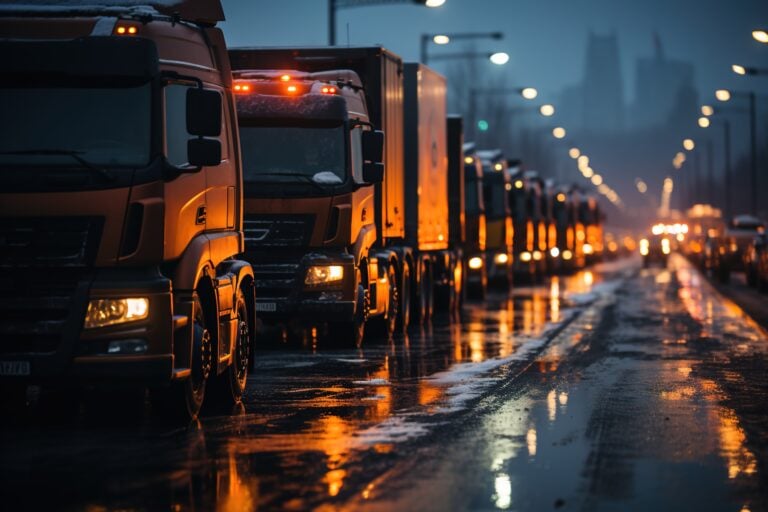Background to cross-border logistics in the EU
The historical importance of the free movement of goods and services within the EU has created the basis for cross-border logistics. This freedom was essential for the functioning of the internal market and the economic success of the member states. The EU member states have agreed on common rules and procedures to enable the smooth movement of goods. This foundation has made the EU one of the world’s largest trading blocs.
Current logistical challenges
Even before the COVID-19 pandemic and other crises, some countries faced inadequate cross-border logistics, e.g. in the form of delays at border crossings, complex regulations and bureaucratic processes, and coordination problems between member states.
Uncertainties about different regulations and the uncoordinated reactions of Member States further complicate the planning and execution of cross-border transportation. But what exactly are these challenges? We take a closer look at them:
Long waiting times at border crossings
One of the biggest challenges for cross-border logistics is long waiting times at border crossings. Especially during the COVID-19 pandemic, different health and safety regulations in the individual EU member states led to delays in freight transport.
However, even without the threat of a pandemic, current developments show that the problem of long waiting times at border crossings persists. The extension of internal border controls between Germany, Poland, the Czech Republic and Switzerland until mid-June 2024 is further exacerbating the situation at borders. This measure, introduced to combat smuggling and limit irregular migration, is currently causing delays in freight transport once again. Truck drivers are therefore still being forced to wait for hours or even days at the borders, causing considerable disruption to supply chains.
Regulatory complexity and bureaucratic hurdles
Unclear regulations and bureaucratic hurdles continue to pose a major problem for cross-border freight transport in the EU. Each EU country has its own regulations and procedures, which makes it difficult for logistics companies to prepare for cross-border transportation. This leads to uncertainty and additional bureaucracy, which affects the efficiency of supply chains. One example of this is Brexit, which has created additional complexity and uncertainty for trade between the UK and EU member states.
Lack of coordination between countries
A fundamental problem in cross-border logistics is also the lack of coordination between EU member states. While some countries have taken effective measures to deal with border crossing issues, others lack a coordinated strategy. This leads to inconsistencies and disparities in measures that further complicate cross-border logistics.
Strategies and current logistics dynamics
Various solutions are being pursued to meet the challenges of cross-border logistics in the EU. The improvement of cross-border infrastructure, such as the expansion of roads, bridges and border checkpoints as well as the introduction of modern monitoring technologies, are important steps towards reducing bottlenecks at the borders.
Harmonization of regulations and procedures between member states is also crucial to reduce bureaucratic hurdles and improve the efficiency of supply chains. Increased coordination at EU level is essential, with the EU Commission and other relevant institutions playing a leading role in coordinating measures between Member States.
Current logistics dynamics show that some countries are better at dealing with the challenges of cross-border logistics than others. For example, Denmark, together with Autobahn GmbH in Germany, has taken promising measures to reduce bottlenecks at borders and facilitate the movement of goods.
In contrast, countries such as Austria continue to struggle with long waiting times at the borders with Bavaria, which has led to delays in the movement of goods for many years. These differences highlight the importance of successful cross-border logistics strategies and the need for improved coordination between Member States.
IMERA as an instrument for crisis management
The Internal Market Emergency and Resilience Act (IMERA) is a key instrument for managing crises in the internal market. It aims to facilitate the cross-border movement of vital goods and services while protecting the fundamental rights of citizens. IMERA aims to avoid bottlenecks in the logistics chain and strengthen the resilience of the internal market.
A practical example of the application of IMERA would be the following scenario: in the event of a sudden outbreak of a pandemic or other crisis that impedes trade within the EU, IMERA could enable EU authorities to act quickly to facilitate the cross-border movement of urgently needed goods. In such a situation, customs formalities could be simplified or time-limited to speed up deliveries and minimize bottlenecks.
IMERA creates clear structures for crisis management and promotes flexibility to react quickly to changing circumstances. The introduction of a “blacklist” of reasons that no longer justify border closures is intended to ensure that Member States can no longer close their borders arbitrarily. In addition, the European Commission will develop forms to make it easier for service providers and workers to cross borders even during crises. This is a first step towards the digitalization of border crossings and will help to avoid bottlenecks in the logistics chain.
International cooperation and global impact
The challenges of cross-border logistics in the EU also have a global impact. In an increasingly interconnected global economy, the EU and its trading partners depend on smooth trade flows. Disruptions in the EU can therefore also have an impact on global supply chains. Even greater international cooperation is therefore crucial to manage crises and strengthen the resilience of global trade flows. This requires not only close cooperation between EU Member States, but also coordination with international partners and organizations such as the WTO and other regional trading blocs. A joint effort can protect global trade flows and minimize the impact of crises on the global economy.
Conclusion
The EU faces complex challenges in its cross-border logistics, especially during times of crisis, which affect both internal coordination and international cooperation. Measures such as IMERA aim to strengthen the resilience of the internal market and ensure smooth trade flows. The harmonization of regulations and improved coordination between member states are essential to minimize bottlenecks and bureaucratic hurdles. Ultimately, the effectiveness of cross-border logistics has a far-reaching impact on the global economy and requires continuous adaptation and cooperation at all levels.









